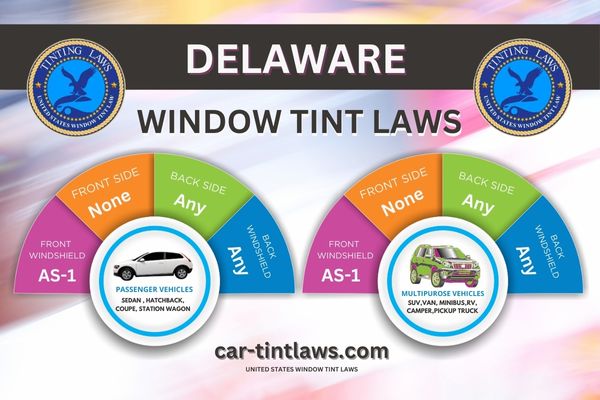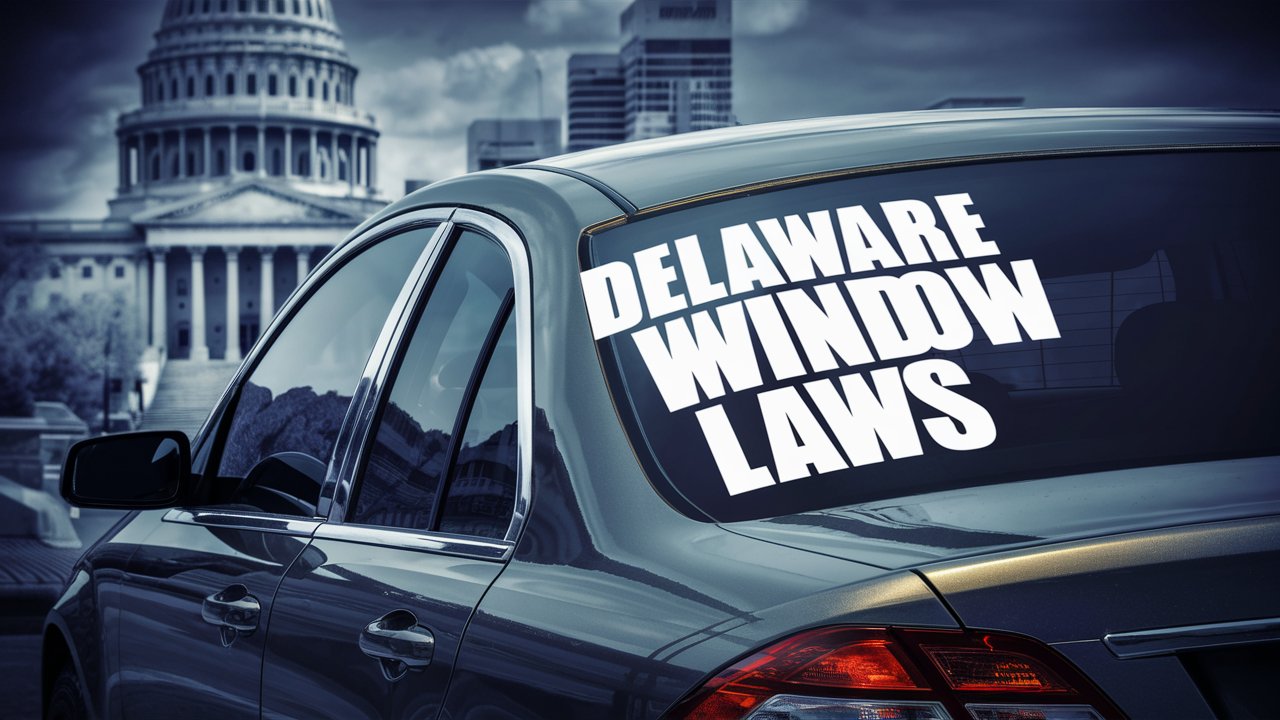When you’re considering tinting your car windows in Delaware, it’s essential to understand the state’s specific regulations.
Delaware’s laws vary depending on whether you drive a sedan or another type of vehicle, and they set strict limits on how much light must pass through your windows.
Reflective tints are completely off-limits, and violations can lead to fines. But did you know there are medical exemptions available?
With proper documentation, you can legally have a darker tint for medical reasons.
Curious about how these exemptions work and what else you need to know to stay compliant?
Window Tint Darkness in Delaware
When it comes to tint darkness in Delaware, you’ll find that the rules are different for sedans compared to SUVs and vans.
For sedans, the front side windows must allow more light in, while the back side and rear windows can be tinted to any darkness level.
On the other hand, SUVs and vans can have any level of tint on their rear windows, making the standards more consistent across these vehicle types.
Tint darkness for sedans:
- Windshield: Non-reflective tint above the AS-1 line is permitted.
- Front Side windows: Must remain clear of aftermarket tint.
- Back Side windows: Can be tinted to any level of darkness.
- Rear Window: Can be tinted to any degree of darkness.
Tint darkness for SUV and Vans:
- Windshield: No tint is allowed, except for the top 4 inches.
- Front Side windows: Must allow more than 70% of light in.
- Back Side windows: Any shade can be used, including 5% VLT.
- Rear window: Any shade can be used, as long as it is not reflective.
Window Tint Reflection in Delaware
When it comes to tint reflection in Delaware, you’ll find that the rules are strict across all types of vehicles, including sedans, SUVs, and vans.
Reflective window tints are not permitted on any vehicle windows, ensuring that all drivers maintain a clear line of sight.
This prohibition applies uniformly, making it essential to comply with these regulations to avoid penalties and contribute to road safety.
Tint reflection for sedans:
- Front Side windows: Excessive reflection can be distracting for both you and other drivers on the road. To avoid this, consult a professional who specializes in Window Tinting for non-reflective options.
- Back Side windows: Delaware’s laws emphasize maintaining visibility and safety. Excessive tint reflection can cause glare, reducing your ability to see clearly and making it harder for others to see you. It’s crucial to adhere to regulations for a safer driving experience.
- Compliance Importance: Properly regulated tint reflection is vital for maintaining transparency and clarity in your sedan’s windows. By following these guidelines, you contribute to safer roadways for everyone.
Tint reflection for SUV and vans:
- Front Side windows: Must not have a shiny or metallic finish.
- Back Side windows: Must not have a shiny or metallic finish.
- Other Windows (excluding windshield): Any darkness level is allowed as long as they don’t have a shiny or metallic finish.
Other Delaware window tint rules and regulations
- Side Mirrors: No restrictions.
- Restricted Colors: In Delaware, all tint colors are permitted.
- Certificates: Manufacturers of film need to certify the film they sell in the state. Ask your dealer if they are using certified film.
- Stickers: The sticker/label of compliance to identify legal tinting is required between the film & glass on each tinted window.
- Medical Exceptions: Delaware permits medical exemptions for special tint. For more details about the specific terms of the exemption, consult DE state law.
- Penalties: The fine for non-compliance with window tint laws in Delaware can vary. It’s important to display the required stickers on the driver’s side window for any aftermarket tint to avoid penalties.

Medical Exemptions for Window Tint Rules in Delaware
Understanding Delaware’s window tinting laws can be easier if you know about the medical exemptions available for qualifying conditions.
If you have a condition like Lupus, Porphyria, or Xeroderma Pigmentosum, you may be eligible for a medical exemption that allows you to have window tint of any darkness.
Delaware tint laws recognize the need for these exemptions and make provisions to guarantee those with certain medical conditions can protect themselves from harmful UV rays.
To apply for a medical exemption, you’ll need a certification from a licensed physician.
The MV495 form is essential for this process. This form must be filled out accurately and completely, and it’s important to follow the application process properly to obtain your waiver.
Any licensed physician in good standing can provide the necessary certification, so you have options when seeking this documentation.
Proper documentation and compliance are key. Make sure everything is in order before submitting your application.
Once approved, your exemption allows for window tinting that accommodates your medical needs, ensuring you can drive comfortably and safely.
Understanding these steps can help you navigate Delaware’s tint laws more effectively.
Delaware Window Tint Ticket Cost
Facing a Delaware window tint ticket can hit your wallet hard, with fines ranging from $25 to $115 depending on the severity of the violation.
If you don’t follow Delaware’s tinting laws, you could be pulled over and fined by a law enforcement officer during a routine traffic stop.
It’s not just about paying the fine; you might also be required to remove the illegal tint, which can be both costly and inconvenient.
In some cases, you might even need to get your vehicle inspected to guarantee compliance.
To avoid these hassles, it’s essential to consult Delaware’s tinting laws before applying any film to your windows, especially the front ones.
Delaware has specific regulations on how dark or reflective your window tint can be, and adhering to these rules can save you from unexpected expenses and legal issues.
Understanding these laws not only keeps you compliant but also ensures you’re driving safely and legally.
Taking the time to familiarize yourself with these regulations is a wise move, helping you avoid the unnecessary stress and financial burden of a window tint ticket.
Delaware Population and Area
Delaware, with a population of approximately 990,837 residents and a total area of 1,982 square miles, is the second smallest state in the U.S.
Despite its small size, it has a high population density of 500.8 people per square mile, which impacts both urban and rural areas.
Understanding these demographics and geographic factors is essential when considering how window tinting laws affect various communities within the state.
Population Density Insights
Despite its small size, Delaware’s high population density of approximately 504 individuals per square mile makes it one of the most densely populated states in the U.S.
With a total area of around 1,982 square miles, the state’s population of over 990,000 residents is primarily concentrated in urban areas like Wilmington and Dover.
This high population density can have implications for various aspects of daily life, including traffic and privacy concerns.
When considering window tinting for your vehicle, understanding the relevant laws in Delaware is crucial.
Please consult the state regulations to make sure your tinted windows comply with legal standards.
Specifically, the AS-1 line is a key marker you need to be aware of, as it indicates the maximum extent to which tinting is allowed on the front windshield.
In Delaware, adhering to window tinting laws is important not only for avoiding fines but also for ensuring safety and visibility on the road.
Given the state’s dense population, following these guidelines is particularly vital to maintain a harmonious and safe driving environment.
Understanding and respecting these laws will help you navigate Delaware’s roads responsibly.
Geographic Size Comparison
Although Delaware is the second smallest state in the U.S., its population density of around 504 people per square mile makes it one of the most densely populated.
With a compact area of approximately 1,982 square miles and a population exceeding 990,000, Delaware ranks 45th in population among U.S. states.
This small size allows for efficient transportation and easy access to amenities, fostering a sense of community among residents.
Despite its small geographic footprint, Delaware boasts a diverse population with various ethnicities and backgrounds.
This diversity enriches the cultural fabric of the state, making it a unique place to live and work.
The high population density means you’re never too far from your neighbors, creating opportunities for social interactions and community involvement.
When it comes to window tinting laws, understanding Delaware’s specific regulations is crucial.
For example, the state has strict rules regarding side windows: no aftermarket tint is permitted.
If you’ve ever encountered the issue where your requested URL was rejected while searching for local tinting services, it’s likely due to these stringent regulations.
Staying informed about these laws guarantees your vehicle complies with state standards and avoids potential penalties.
Urban Vs Rural Areas
You’ll find that Delaware’s population is mainly urban, with bustling cities like Wilmington and Dover leading the way.
These urban areas are densely populated and developed, offering a high concentration of businesses, services, and infrastructure.
If you’re driving through these cities, you’ll notice a greater number of vehicles on the road, and window tinting can provide some much-needed privacy and comfort.
However, it’s important to make sure that your side windows comply with Delaware’s tinting laws to avoid any legal issues.
On the other hand, Delaware’s rural areas, such as Sussex County, present a different lifestyle.
With a focus on agriculture, smaller communities, and open spaces, the rural parts of Delaware offer a more relaxed pace of life.
While you might not encounter as much traffic here, window tinting can still be beneficial for reducing glare from the sun during long drives through the countryside.
Understanding the differences between urban and rural areas in Delaware can help you appreciate the diverse environments within the state.
Whether you’re navigating the busy streets of Wilmington or enjoying the scenic routes of Sussex County, adhering to window tinting regulations is essential for a smooth and lawful driving experience.
References
Delaware DMV – Vehicle Equipment (scroll to end)
Frequently Asked Questions
What Is the Darkest Legal Tint in Delaware?
You’re wondering about the darkest tint allowed in Delaware. While there’s no specific limit, generally, 5% VLT is considered the darkest legal tint.
This guarantees vehicle visibility and helps you avoid extra window tinting costs.
Do You Need a Tint Waiver in Delaware?
Did you know 30% of drivers in Delaware seek exemptions? You’ll need a tint waiver if your medical condition requires it.
Understand the tint percentage limits and enforcement procedures to stay compliant and belong to our safe driving community.
What Is the Darkest Legal Tint for a Car?
The darkest legal tint for a car is generally around 5% VLT.
Understanding tint percentages, maintaining tint visibility, and ensuring tint safety will help you comply with regulations and avoid fines. Stay safe and follow the rules!
What State Has the Darkest Tint Law?
Investigate the theory: some states with strict legal tint limits might enforce them rigorously.
Comparing state tint darkness laws, Delaware stands out with the darkest legal tint, impacting visibility and safety, providing flexibility yet requiring adherence.
Conclusion
maneuvering Delaware’s window tinting laws demands attention to detail and adherence to specific regulations.
With different requirements for sedans and the ban of reflective tints, adherence guarantees both safety and legality.
Medical exemptions provide flexibility for individuals with documented needs, but infringements can be expensive.
Therefore, unless you appreciate fines and the inconvenience of rectifying unlawful tints, it’s advisable to acquaint yourself with these regulations and uphold proper visibility on the road.
